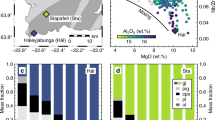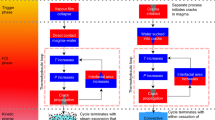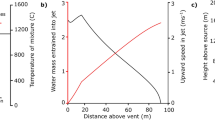Abstract
Although magma mixing is an old concept which has been applied to many magma types, recent petrographic studies have revived interest in the theory by suggesting that it may account for the origin of calk-alkaline magma1–6 and mid-ocean ridge basalt7–9. There has been no previous experimental investigation into how two magmas with different properties can mix to form a homogeneous magma of andesitic composition or to produce textures such as observed in banded dacite. We present here the results of experiments demonstrating that basaltic and dacitic magmas can be easily mixed by forced convection to form both banded dacite and homogeneous andesite in less than a few hours.
This is a preview of subscription content, access via your institution
Access options
Subscribe to this journal
Receive 51 print issues and online access
$199.00 per year
only $3.90 per issue
Buy this article
- Purchase on Springer Link
- Instant access to full article PDF
Prices may be subject to local taxes which are calculated during checkout
Similar content being viewed by others
References
Eichelberger, J. C. Bull. geol Soc. Am. 86, 1381–1391 (1975).
Anderson, A. T. J. Volcanol. geotherm. Res. 1, 3–33 (1976).
Eichelberger, J. C. Nature 275, 21–27 (1978).
Sakuyama, M. J. Volcanol. geotherm. Res. 5, 179–208 (1979).
Luhr, J. F. & Carmichael, I. S. E. Contr. Miner. Petrol. 71, 343–372 (1980).
Sakuyama, M. J. Petrol. 22, 553–583 (1981).
Donaldson, C. H. & Brown, R. W. Earth planet. Sci. Lett. 37, 81–89 (1977).
Dungan, M. A. & Rhodes, J. M. Contr. Miner. Petrol. 67, 417–431 (1978).
Walker, D., Shibata, T. & DeLong, S. F. Contr. Miner. Petrol. 70, 111–125 (1979).
Yoder, H. S. Jr & Tilley, C . E. J. Petrol. 3, 342–532 (1962).
Nakagawa, M. J. Jap. Ass. Miner. Petrol. Econ. Geol. (in the press).
Akashi, T., Matsumi, K., Okada, T. & Mizutani, T. IEEE Trans. Magn. MAG- 5, 285–289 (1969).
Fujimaki, H. & Aoki, K. Sci. Rep. Tohoku Univ. Ser. III 14, 261–268 (1980).
MacDonald, G. A. & Katsura, T. Bull. geol. Soc. Am. 76, 475–482 (1965).
Kouchi, A. & Sunagawa, I. Sci. Rep. Tohoku Univ. Ser. III 15, 163–175 (1982).
Yoder, H. S. Jr Am. Miner. 58, 153–171 (1973).
Watson, E. B. Contr. Miner. Petrol. 80, 73–87 (1982).
Eichelberger, J. C. Nature 288, 446–450 (1980).
Author information
Authors and Affiliations
Rights and permissions
About this article
Cite this article
Kouchi, A., Sunagawa, I. Mixing basaltic and dacitic magmas by forced convection. Nature 304, 527–528 (1983). https://doi.org/10.1038/304527a0
Received:
Accepted:
Issue Date:
DOI: https://doi.org/10.1038/304527a0
This article is cited by
-
Mixing between chemically variable primitive basalts creates and modifies crystal cargoes
Nature Communications (2021)
-
Pre-eruptive conditions and triggering mechanism of the ~ 16 ka Santa Bárbara explosive eruption of Sete Cidades Volcano (São Miguel, Azores)
Contributions to Mineralogy and Petrology (2019)
-
Petrological cannibalism: the chemical and textural consequences of incremental magma body growth
Contributions to Mineralogy and Petrology (2013)
-
Geochemical, zircon U–Pb dating and Sr–Nd–Hf isotopic constraints on the age and petrogenesis of an Early Cretaceous volcanic-intrusive complex at Xiangshan, Southeast China
Mineralogy and Petrology (2011)
-
Time-scales of hybridisation of magmatic enclaves in regular and chaotic flow fields: petrologic and volcanologic implications
Bulletin of Volcanology (2006)
Comments
By submitting a comment you agree to abide by our Terms and Community Guidelines. If you find something abusive or that does not comply with our terms or guidelines please flag it as inappropriate.



